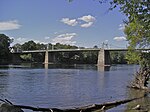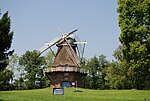George Hunt House
Houses completed in 1825Houses in Warren County, New JerseyHouses on the National Register of Historic Places in New JerseyNational Register of Historic Places in Warren County, New JerseyNew Jersey Register of Historic Places ... and 4 more
New Jersey Registered Historic Place stubsPohatcong Township, New JerseyStone houses in New JerseyUse mdy dates from August 2023

The George Hunt House is a historic building located southwest of Alpha at 135 Warren Glen Road in Pohatcong Township, Warren County, New Jersey. It was built c. 1825 near the confluence of the Musconetcong River with the Delaware River. The house was added to the National Register of Historic Places on September 12, 1979, for its significance in architecture.
Excerpt from the Wikipedia article George Hunt House (License: CC BY-SA 3.0, Authors, Images).George Hunt House
Riegelsville Warren Glen Road, Pohatcong Township
Geographical coordinates (GPS) Address Nearby Places Show on map
Geographical coordinates (GPS)
| Latitude | Longitude |
|---|---|
| N 40.598333333333 ° | E -75.1825 ° |
Address
Riegelsville Warren Glen Road 63
08865 Pohatcong Township
New Jersey, United States
Open on Google Maps










